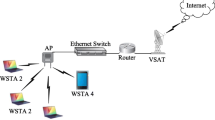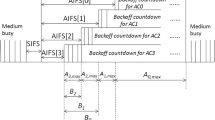Abstract
The 802.11 WLAN legacy standard cannot provide Quality of Service (QoS) support for multimedia applications because the 802.11 was initially developed for Best Effort services. Hence, the 802.11e amendment was published in order to provide the QoS support to WLANs. One of the most important functions in 802.11e is the contention based channel access mechanism called Enhanced Distributed Channel Access (EDCA), which provides a priority scheme by differentiating the Arbitration Inter Frame Space (AIFS), initial window size and Transmission OPportunity limit (TXOPlimit). In this paper, we propose a novel analytical model for the performance analysis of the IEEE 802.11e EDCA network with Contention Free Burst under fading channel and saturated traffic conditions. This new model captures all of the major QoS specific features, namely AIFS, minimum contention window size, maximum contention window size, virtual collision and TXOPlimit. So, we have analyzed the saturation system throughput of the basic access method of the IEEE 802.11e EDCA network.
















Similar content being viewed by others
References
Kong, Z., Tsang, D. H. K., Bensaou, B., & Guo, D. (2004). Performance analysis of IEEE 802.11e contention-based channel access. IEEE Journal Selected Areas Communications, 22, 2095–2106.
Xiao, Y. (2003). Enhanced DCF of IEEE 802.11e to support Qos. In Proceedings of IEEE WCNC’03, New Orleans, Louisiana (Vol. 2, pp. 1291–1296).
IEEE Draft Standard 802.11e/D13.0 (2005).
Wireless medium access control (MAC) and physical layer (PHY) specification: Medium access control (MAC) enhancements for quality of Service(QoS), IEEE Std. 802.11e/Draft 5.0 (2003).
Choi, S., Prado, J. D., Shankar, S., & Mangold, S. (2003). IEEE 802.11e contention-based channel access (EDCF) performance evaluation. In Proceedings IEEE ICC’03 (Vol. 2, pp. 1151–1156).
Bianchi, G. (2000). Performance analysis of the IEEE 802.11 distributed coordination function. IEEE Journal on Selected Areas Communications, 18, 535–547.
Ziouva, E., & Antonakopoulos, T. (2002). CSMA/CA performance under high traffic conditions: Throughout and delay analysis. Computer Communication, 25, 313–321.
Wu, H., Peng, Y., Long, K., Cheng, S., & Ma, J. (2002). Performance of reliable transport protocol over IEEE 802.11 wireless LAN: Analysis and enhancement. In IEEE information communications (INFOCOM), New York (pp. 599–607).
Yin, J. (2007). The analysis of performance of IEEE 802.11 MAC protocol using Markov chain. IJCSNS International Journal of Computer Science and Network Security, 7, 27–37.
Yun, J. H. (2013). Performance analysis of IEEE 802.11 WLANs with rate adaptation in time-varying fading channels. Computer Networks, 57, 1153–1166.
Kosek-Szott, K. (2014). A comprehensive analysis of IEEE 802.11 DCF heterogeneous traffic sources. Ad hoc Networks, 16, 165–181.
Yazid, M., Bouallouche-Medjkoune, L., Assani, D., Amrouche, N., & Bakli, K. (2013). Analytical analysis of applying packet fragmentation mechanism on both basic and RTS/CTS access methods of the IEEE 802.11b DCF network under imperfect channel and finite load conditions. Wireless Personal Communications. doi:10.1007/s11277-013-1517-x.
Mangold, S., Choi, S., May, P., Klein, O., Hiertz, G., & Stibor, L. (2002). IEEE 802.11e wireless LAN for quality of service. In Proceedings of the European wireless, Florence, Italy (Vol. 1, pp. 32–39).
Xiao, Y. (2005). Performance analysis of priority schemes for IEEE 802.11 and IEEE 802.11e wireless LANs. IEEE Transactions on Wireless Communications, 4, 1506–1515.
Tinnirello, I., & Choi, S. (2005). Efficiency analysis of burst transmissions with block ACK in contention-based 802.11e WLANs. In Proceedings of IEEE ICC05, Seoul, Korea (Vol. 5, pp. 3455–3460).
Li, T., Ni, Q., Turletti, T., & Xiao, Y. (2005). Performance analysis of the IEEE 802.11e block ACK scheme in a noisy channel. In Proceedings IEEE BroadNets05.
Tursunova, S., & Kim, Y. T. (2012). Realistic IEEE 802.11e EDCA model for QoS-aware mobile cloud service provisioning. IEEE Transactions on Consumer Electronics, 58, 60–68.
Gas, M., Kosek-Szott, K., Natkaniec, M., & Pach, A. R. (2011). 3D Markov chain-based saturation throughput model of IEEE 802.11 EDCA. Electronics Letters, 47, 826–827.
Peng, F., Alnuweiri, H. M., & Leung, V. C. M. (2006). Analysis of burst transmission in IEEE 802.11e wireless LANs. In Proceedings of IEEE ICC06, Istanbul (Vol. 2, pp. 535–539).
Hu, J., Min, G., & Woodward, M. E. (2011). Modeling and analysis of TXOP differentiation in infrastructure-based WLANs. Computer Networks, 55, 2545–2557.
Robinson, J. W., & Randhawa, T. S. (2004). Saturation throughput analysis of IEEE 802.11e enhanced distributed coordination function. IEEE Journal Selected Areas Communications, 22, 917–928.
Mangold, S., Hiertz, G., & Walke, B. (2003). IEEE 802.11e wireless LANResource sharing with contention based medium access. In Proceedings of IEEE PIMRC, Beijing, China (Vol. 3, pp. 2019–2026).
Hu, J., Min, G., & Woodward, M. E. (2011). Performance analysis of the TXOP burst transmission scheme in single hop ad hoc networks with unbalanced stations. Computer Communications, 34, 1593–1603.
Xiao, Y. (2004). Performance analysis of IEEE 802.11e EDCF under saturation condition. In Proceedings of IEEE ICC, Paris, France (pp. 170–174).
Yao, Y. C., et al. (2013). The Performance Evaluation of IEEE 802.11e for QoS Support in Wireless LANs. Wireless Personal Communications, 69, 413–424.
Varposhti, M., & Movahhedinia, N. (2009). Supporting Qos in IEEE 802.11e wireless LAN’s over fading channel. Computer Communications, 32, 985–991.
Xu, D., Sakurai, T., & Vu, H. L. (2009). An access delay model for IEEE 802.11e EDCA. IEEE Transactions on Mobile Computing, 8, 261–275.
Hu, J., Min, G., Woodward, M. E., & Jia, W. (2012). Comprehensive QoS analysis of enhanced distributed channel access in wireless local area networks. Information Sciences, 214, 20–34.
Kosek-Szott, K., Natkaniec, M., & Pach, A. R. (2011). A simple but accurate throughout model for IEEE 802.11 EDCA in saturation and non-saturation conditions. Computer Networks, 55, 622–635.
Peng, F., Shafiee K., & Leung, V. C. M. (2012). Throughput modeling of differentiation schemes for IEEE 802.11e MAC protocol. In Proceedings of the IEEE VTC Fall (pp. 1–5).
Luo, H., & Shyu, M. (2011). Quality of service provision in mobile multimedia a survey. Human Centric Computing and Information Sciences, 1, 1–15.
Latkoski, P., Hadzi-Velkov, Z., & Popovski, B. (2005). Performance analysis of IEEE 802.11a WLAN in block fading channel using SDL simulation. In Proceedings of IEEE TELSIKS (Vol. 1, pp. 97–100).
Yin, J., Wang, X., & Agrawal, D. P. (2004). Optimal packet size in error-prone channel for IEEE 802.11 distributed coordination function. In Proceedings of IEEE international conference on wireless communications and networking conference (WCNC) (Vol. 3, pp. 1654–1659).
Wireless LAN Medium Access Control (MAC) and Physical Layer (PHY) Specifications, ISO/IEC IEEE 802.11 Standard (1999).
IEEE 802.11 WG, IEEE 802.11d, part 3: Mac bridges, ANSI/IEEE Std. 802.11D, 1998 edition (1998).
Beuran, R. (2006). VoIP over Wireless LAN survey. Internet Research Center Japan Advanced Institute of Science and Technology (JAIST).
Xiao, Y. (2004). IEEE 802.11e: A QoS provisioning at the MAC layer. IEEE Wireless Communications, 11, 72–79.
Network Simulator-NS2. [Online]. http://www.isi.edu/nanam/ns/.
Author information
Authors and Affiliations
Corresponding author
Rights and permissions
About this article
Cite this article
Bachiri, L., Aïssani, D. & Bouallouche-Medjkoune, L. Saturation Throughput Analysis of the IEEE 802.11e EDCA Network with Contention Free Burst Under Fading Channel. Wireless Pers Commun 79, 545–564 (2014). https://doi.org/10.1007/s11277-014-1872-2
Published:
Issue Date:
DOI: https://doi.org/10.1007/s11277-014-1872-2




